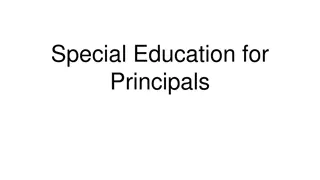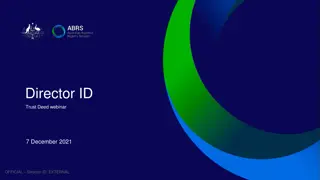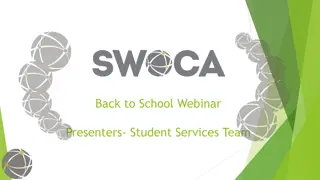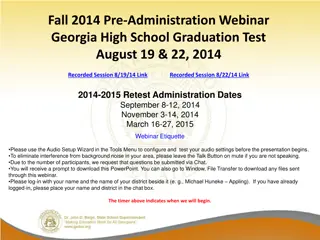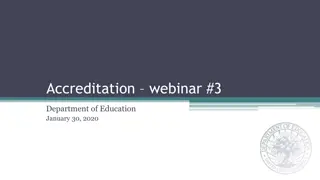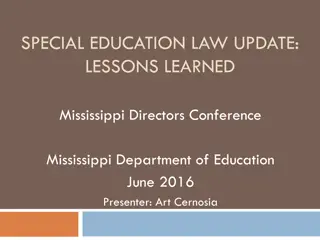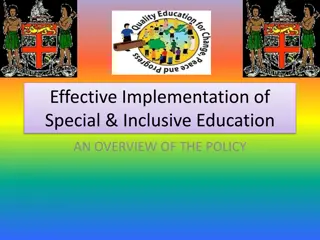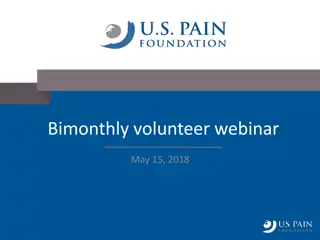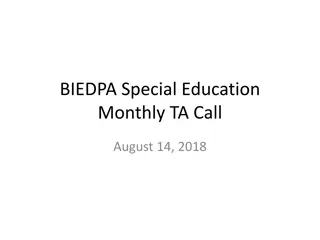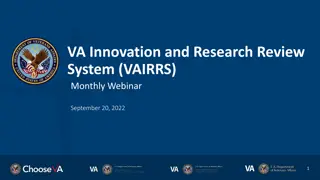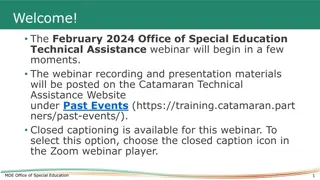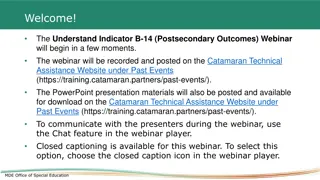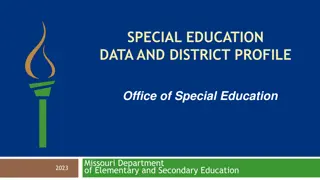Updates on Special Education Director's Webinar
This webinar covers topics like Specially Designed Instruction, Graduation Pathways, Guidance Documents, Structured Learning, Adjusting Instruction, and Helping Students Access General Education. It provides guidance on adjusting curriculum choices, instructional methods, and accessing academic materials for students with diverse learning needs.
Download Presentation

Please find below an Image/Link to download the presentation.
The content on the website is provided AS IS for your information and personal use only. It may not be sold, licensed, or shared on other websites without obtaining consent from the author.If you encounter any issues during the download, it is possible that the publisher has removed the file from their server.
You are allowed to download the files provided on this website for personal or commercial use, subject to the condition that they are used lawfully. All files are the property of their respective owners.
The content on the website is provided AS IS for your information and personal use only. It may not be sold, licensed, or shared on other websites without obtaining consent from the author.
E N D
Presentation Transcript
Distance Learning For All Updates Special Education Director s Webinar April 10, 2020 We will be starting soon. Please mute yourselves upon entering this meeting. Thank you!
Topics Covered Today Specially Designed Instruction Graduation Pathways: Implications for Special Education Guidance Documents and Resources FAQ
Full School Day Grade Level Teacher-Led Learning Structured, grade-level learning directed by teacher and supported by teacher. Learning and Supplemental Activities In addition to Teacher-Led Learning, led by the student and/or family. Meeting Nutrition and Wellness Needs Breakfast, Lunch, Snack and Recess/Play breaks. K-1 45 Minutes Maximum 1-2 Hours Recommended 2 Hours Recommended 2-3 60 Minutes Maximum 2 Hours Recommended 2 Hours Recommended 4-5 90 Minutes Maximum 3 Hours Recommended 2 Hours Recommended 6-8 30 Minutes per Subject; 3 hours Maximum 1-2 Hours Recommended 2 Hours Recommended 9-12 30 Minutes per Subject; 3 hours Maximum 1-2 Hours Recommended 2 Hours Recommended
Adjusting Specially Designed Instruction Adjustments to curriculum choices, modalities, instructional materials and methods DO NOT require an amendment to the IEP. Most students IEPs could be implemented in the DL4A Plan without adjustment. Adjustments to time, should be based on individual student needs and the District's DL4A Plan. This will require an IEP amendment, parent participation, and a Prior Written Notice.
Helping Students Access General Education first Adapted and shared from partners- not an exhaustive list Co-plan with gen ed teams regularly Bring UDL lens in planning process to the activities Ensure IEP goals can be addressed in the lessons or with scaffolded additions (fluency example, main idea example) Be prepared to bring ideas and materials for modifications for students with most diverse learning needs Gather information on weekly check-ins to support what is going well for students in accessing their education and resolve barriers Engage in assessment around IEP goals
Considerations when planning SDI Rating 1 2 3 4 5 How much student and family can access K-5 distance learning packet instruction None A little bit About half Most of it All Rating 1 2 3 4 5 How much student and family can access 6-12 online distance learning instruction None A little bit About half Most of it All Supports, accommodations, consultation, and services will be provided to ensure access to academic materials and help student make continued progress with IEP Goals and Objectives Starting April 13
Specially Designed Instruction Specially Designed Instruction (SDI) means adapting, as appropriate to the needs of each student, the content, methodology or delivery of instruction for the following purposes: (1) To address the unique needs of the student that result from the student s disability; and (2) To ensure access of any student experiencing a disability to the general curriculum in this instance, the district s Extended School Closure Guidance plan, so that the student can meet the educational standards within the jurisdiction of the agency that apply to all children.
Specially Designed Instruction Examples SDI for reading comprehension MIGHT look like: Determine a high leverage strategy to improve reading comprehension: in this case, using a graphic organizer to map story grammar Embed a graphic organizer in all the students google classroom or other platform who will need this lesson, mail the organizer with other materials, or send pictures of it. Your student can access this organizer (and others may as well) Make sure the teacher includes one activity that involves finding applying story grammar questions
Specially Designed Instruction Examples SDI for Spelling MIGHT look like: Determine a high leverage strategy to improve spelling: ex: LOOK-SAY-COVER-WRITE-CHECK Embed a video on the spelling strategy in the classroom with the general ed teacher. Your student can access this video (and others may as well) Make sure the teacher includes one activity that involves spelling that week. This can also be adapted to over the phone with a student.
Specially Designed Instruction Examples SDI for Self-Management for following 3 step directions MIGHT look like, embedded in HS Science Determine what standard/learning target is being taught in the lesson that week (use a model to determine how photosynthesis turns light energy into chemical energy). Create a simple 3 step direction activity to assemble a poster based on a provided chart or organizer. Embed this direction in the science class s google classroom as an individual assignment - can be done over the phone as well. Communicate to parents a prompting script and rubric.
Graduation Pathways 2020 Ensures clear pathways to graduation for seniors Keeps learning aspirations high and helps protect future success Honors the significant learning and accomplishments of students over time and high standards for learning and achievement (maintains credit requirements) Allows seniors to receive credit for any course in which they were passing at the time of the extended school closure Aim is to mitigate negative consequences from any lost learning time due to COVID-19 Recognizes and tries to mitigate the other losses our seniors are facing as they exit our public schools (e.g., prom, graduation)
Naming Inequities Problematic paradox around who the system is designed to serve Magnified by the COVID-19 crisis, our students who have been pushed to the edge of our system carry the disproportionate weight of meeting graduation requirements Each of us as educators must acknowledge the predictable inequities in our system and be held accountable to collective action We must heighten our attention to particular groups of students who often bear the burden of the system s oppressive practices Care, Connection, and Continuity of Learning requires an equity stance
Foundational Premise We will honor and recognize that seniors dedicated 12 years and 7 months of learning and progress during their K- 12 careers. Our goal is to hold students harmless, recognize their accomplishments and protect their future plans. Less than 2 percent of seniors total K-12 learning time has been impacted by COVID-19.
Graduation Requirements Guidance for Graduation Pathways 2020 relates only to current high school seniors Provides options and recommendations to award credits for seniors that account for their work and accomplishments up to the point of school closure
Whats Essential Maintain current Oregon Diploma, Oregon Modified Diploma, and Oregon Extended Diploma subject-area and credit requirements. Award subject-area credit based on a senior s progress or demonstrated proficiency as of school closure. Award a diploma if a senior was on track to graduate prior to the closure. Ensure opportunity for seniors to earn credit for course work or learning they have engaged with since the school closure. Assign seniors Pass/Incomplete for all courses impacted by school closure. Suspend all Essential Skills and Personalized Learning requirements for seniors.
Reconciling Credit Seniors shall be awarded credit based on a Pass/Incomplete determination Generally, if a senior was passing (A-D or equivalent), they should be awarded a Pass status for a course. If they were not yet passing (F or equivalent), they should be awarded an Incomplete . Districts shall provide opportunities for seniors awarded an incomplete to improve to a passing grade without starting over, preferably by the end of the school year (but before August 31) Do not penalize any seniors when determining whether credit should be awarded, taking into account where accommodations and supports such as extended time could not be provided due to COVID school closure.
Requirements and Recognition Align all requirements for earning an Oregon Diploma with ODE guidance in order to ensure fair and equitable treatment of seniors across the state. Districts may not add additional graduation requirements for seniors in the Class of 2020. Provide additional support and credit-earning opportunities to seniors needing credits to graduate. When developing personalized student graduation plans, reflect the student context, funds of knowledge and learning environment.
Personalized Student Graduation & Transition Plans 1. Review and update teacher gradebooks 2. Use course completion data to determine which seniors are meeting or exceeding credit requirements to graduate and which seniors will need additional support to meet graduation credit requirements 3. Identify and determine support for students 4. Develop a personalized student graduation and transition plan for each student 5. Utilize student s education plan and profile for additional considerations 6. Communicate with seniors and families to share credit status and finalize their graduation pathway plan
Communication Timeline As soon as possible Provide initial communication to families on the process and timeline for determining status for graduation. April 30 Notify each senior s family on their student s graduation status and next steps. August 31 Students meet Oregon Diploma 2020 requirements and receive a 2020 Diploma.
Special Education Services for Seniors When students are on track to graduate, communicate with the family: Oregon Modified Diploma Oregon Extended Diploma Oregon Diploma Transition Services During Closure Transition Services During Closure Termination of Services Discuss FAPE obligation ends with receipt of regular diploma Need IEP meeting if parents want services to continue until originally planned graduation date
Additional Considerations for Seniors with IEPs who may Need Credits to Graduate The district must ensure appropriate services and supports were provided before classifying the senior as not on track This includes: Reviewing IEP records to ensure that district provided FAPE Gathering evidence from each teacher/course that an appropriately developed IEP was fully implemented Ensuring that the parent, guardian, or person in a parental relationship was afforded the opportunity to meaningfully participate in the IEP process
Additional Considerations for Seniors with IEPs who may Need Credits to Graduate, continued The District must document the requirements above in which the senior was considered not on track. This includes evidence that: Specially designed instruction (SDI) was delivered as intended Accommodations, related services and supplementary aids and services were delivered as intended The IEP team worked towards the measurable annual goals contained within the IEP, including progress monitoring data If such documentation cannot be provided, the district shall hold that student harmless during the closure.
Speech-Language Pathology TeleHealth Released in coordination with the Board of Examiners for Speech- Language Pathology and Audiology SLPs, SLPAs, and Audiologists are covered by this guidance Telehealth is allowed by the Board of Examiners. There are requirements for SLP Telehealth already outlined in rule (OAR 335-005-0016). Of note among these: Services must be equivalent in quality to in-person services Services must conform to professional standards Client must be a candidate for telepractice (determined by provider) Telepractitioner has knowledge and skills to competently telepractice Provider must receive prior consent from client/parent/guardian
NOT YET RELEASED Occupational Therapy TeleHealth Reviewed/Vetted by the Oregon Occupational Therapy Licensing Board. OTs and COTAs are covered by this guidance. Telehealth is allowed by the Oregon Occupational Therapy Licensing Board. There are requirements for OT Telehealth already outlined in rule (OAR 339-010-0006). Of note among these: Exercise the same standard of care when providing occupational therapy services via telehealth as with any other mode of delivery Provide services consistent with the AOTA Code of Ethics and Ethical Standards of Practice Provider must receive prior consent from client/parent/guardian
NOT YET RELEASED Physical Therapy TeleHealth Reviewed/Vetted by the Oregon Physical Therapist Board PTs and PTAs are covered by this guidance Physical Therapists and Physical Therapy Assistants are allowed to provide telehealth services. Physical Therapy Aides are not. There are requirements for PT Telehealth already outlined in rule (OAR 848-140-0180). Of note among these: Telehealth services must be at least equivalent to the quality of services delivered in-person. Telehealth services provided must conform to the scope and standards of practice and documentation in ORS (Chapter 688) and OAR. Licensee shall obtain the patient s consent to receive the services via telehealth.
NOT YET RELEASED School Nursing TeleHealth Released in coordination with the Oregon State Board of Nursing School nurses can provide telehealth services in a school setting The exact same nursing scope of practice standards apply regardless of whether nursing services are provided face-to-face or through the use of telecommunications technology The individual nurse has accepts or declines a client assignment based on whether they possess the knowledge, skills, abilities, and competencies to complete the assignment safely The prudent nurse would obtain verbal consent for nursing services and the provision of those services through telehealth technology (not addressed in Act)
Updated Guidance Parent FAQ Parent Guidance Updated to reflect shift to Distance Learning for All Released in coordination with FACT Oregon and DHS/ODDS Added some additional resources Working on translation of special education documents into other languages Developing a central repository for special education guidance related to COVID-19. Estimated to be initially released by 4/13/2020.
Coming Guidance Upcoming Guidance: JDEP/YCEP Programs Mental and Behavioral Health TeleHealth FAQ Student Privacy Considerations and Distance Learning for All This will not be special education specific guidance as FERPA and HIPAA apply to all students It will specifically address privacy during special education service provision Goal is to release before April 13, 2020

 undefined
undefined



 undefined
undefined









